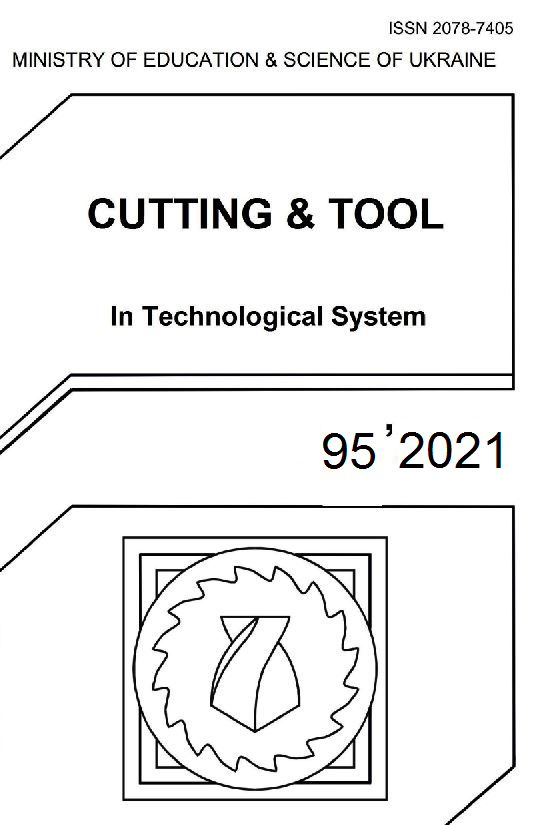ANALYSIS OF THE CHANGE IN ROUGHNESS ON A FACE-MILLED SURFACE MEASURED EVERY 45° DIRECTION TO THE FEED
DOI:
https://doi.org/10.20998/2078-7405.2021.95.04%20%20%20%20Abstract
In this article, we analyze the difference (inhomogeneity) of the roughness values measured on a nonalloy carbon steel surface milled with a parallelogram-shaped (κr = 90°) insert as a function of the the tool movement direction and the relative position of the examining points on the workpiece surface. The characteristic distribution of roughness and the magnitude of the deviations were examined by measuring at selected points along several planes on a surface characterized by the movement conditions of the workpiece and the symmetrically arranged tool perpendicular to the machined surface, which formed double milling marks. The selected points mark the lines with specified inclinations with respect to the feed direction, and their measured values were compared. In these directions, the magnitude of the difference in roughness measures was obtained.
References
Surface Texture Symbols: ASME Y14.36M-1978, American National Standards Institute.
Kundrak, J., Felho, C.: 3D roughness parameters of surfaces face milled by special tools, Manufacturing technology vol.16(3) (2016) pp.532-538.
Kundrak, J., Felho, C.: Topography of the machined surface in high performance face milling, Procedia CIRP vol.77 (2018) pp.340-343.
Felho, C., Kundrak, J.: Characterization of topography of cut surface based on theoretical roughness indexes, Key Engineering Materials vol.496 (2012) pp.194-199.
Felho, C., Kundrak, J.: Comparison of Theoretical and Real Surface Roughness in Face Milling with Octagonal and Circular Inserts, Key Engineering Materials vol.581 (2014) pp.360-365.
Arizmendi, M., Jiménez, A.: Modelling and analysis of surface topography generated in face milling operations, International Journal of Mechanical Sciences vol.163 (2019) ArtNo.105061.
Chuchala, D., Dobrzynski, M., Pimenov, D.Y., Orlowski, K.A., Krolczyk, G., Giasin, K.: Surface roughness evaluation in thin EN AW-6086-T6 alloy plates after face milling process with different strategies, Materials vol.14(11) (2021) ArtNo.3036.
Pham, T. Nguyen, D., Banh, T., Tong, V.: Experimental study on the chip morphology, tool-chip contact length, workpiece vibration, and surface roughness during high-speed face milling of A6061 aluminum alloy, Proceedings of The Institution of Mechanical Engineers Part B - Journal of Engineering Manufacture vol.234(3) (2020) pp.610-620.
Gocke, H.: Optimisation of Cutting Tool and Cutting Parameters in Face Milling of Custom 450 through the Taguchi Method, Advances in Materials Science and Engineering vol.2019 (2019) ArtNo.5868132.
Bruni, C., d'Apolito, L., Forcellese, A., Gabrielli, F., Simoncini, M.: Surface roughness modelling in finish face milling under MQL and dry cutting conditions, International Journal of Material Forming vol.1(1) (2008) pp.503-506.
Saï, K., Bouzid, W.: Roughness modeling in up-face milling, International Journal of Advanced Manufacturing Technology vol.26 (2005) pp.324-329.
Pimenov, D.Y., Hassui, A., Wojciechowski, S., Mia, M., Magri, A., Suyama, D.I., Bustillo, A., Krolczyk, G., Gupta, M.K.: Effect of the relative position of the face milling tool towards the workpiece on machined surface roughness and milling dynamics, Applied Sciences vol.9(5) (2019) ArtNo.842.
Nagy, A., Kundrák, J.: Changes in the values of roughness parameters on face-milled steel surface, Cutting & Tools in Technological Systems vol.92 (2020) pp.85-95.
Downloads
Published
Issue
Section
License
Copyright Notice
Authors who publish with this Collection agree to the following terms:
1. Authors retain copyright and grant the Collection right of first publication with the work simultaneously licensed under a Creative Commons Attribution License that allows others to share the work with an acknowledgement of the work's authorship and initial publication in this Collection.
2. Authors are able to enter into separate, additional contractual arrangements for the non-exclusive distribution of the Collection's published version of the work (e.g., post it to an institutional repository or publish it in a book), with an acknowledgement of its initial publication in this Collection.
3. Authors are permitted and encouraged to post their work online (e.g., in institutional repositories or on their website) prior to and during the submission process, as it can lead to productive exchanges, as well as earlier and greater citation of published work.

